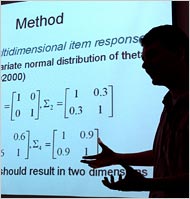
The following is a
guest blog post by
Joel Schneider (Clinical psychologist, Illinois State University), a member of
IQs Corner Virtual Community of Scholars project. Joel reviewed an article by
Valacich et al. (2006) that investigated the question
whether some people are more likely than others to have better ideas while brainstorming when other group members have high-quality ideas. Valacich, J.S., Jung, J.H., & Looney, C.A. (2006). The Effects of Individual Cognitive Ability and Idea Stimulation on Idea-Generation Performance. Group Dynamics: Theory, Research, and Practice, 10, 1-15.Abstract- A computer-based group idea-generation simulator was used to measure the performance of individuals with high and low cognitive ability who received high- or low-quality stimulation; high- and low-quality stimulation was operationalized by presenting controlled idea submissions from simulated group members throughout the idea-generation session. Cognitive ability and stimuli quality interacted such that the high cognitive ability/high-quality stimuli treatment achieved the highest performance. The results suggest that the performance of individuals with high cognitive ability can be enhanced when given high-quality stimuli or be inhibited when exposed to low-quality stimuli. The performance of individuals with low cognitive ability, in contrast, is consistently meager regardless of stimuli quality. The findings suggest that group composition cannot only significantly influence the overall ideational performance of a group, but also that of individual group members. The implications of these findings for future research, as well as the implications for the design of group idea-generation procedures, are discussed.
Summary and Comments by Joel
Brainstorming with People with Bad Ideas Is the Great Equalizer!Earlier this season on Donald Trump’s show,
The Apprentice, one of the teams complained that their ability to function was hampered by a teammate who regularly came up with poor ideas whenever they brainstormed to solve problems. I thought that this team was grasping at straws to justify their poor performance. However, an interesting new study suggests that maybe the excuse was not so bad after all.
Valacich, Jung, and Looney (2006) asked the question whether some people are more likely than others to have better ideas while brainstorming when other group members have high-quality ideas. Such a hypothesis is very difficult to test because group interactions are extremely complex. Measurement of live interaction is a nightmare: people do all sorts of unexpected things! Therefore, to reduce the complexity of the situation and to control the phenomena of interest (idea quality), groups of college students sat at individual computers and were told that they would participate in a computer-mediated group brainstorming session. The task was to generate ideas about how parking problems could be improved at the university (an ideational fluency task in CHC terms). Each participant would see everyone else’s ideas on the computer as they typed their own ideas. In reality, the ideas that popped onto the screen were specially selected ideas from a database instead of the actual ideas from other students in the room. The simulation was apparently realistic because few participants suspected that the ideas were not from other people in the room. Over the course of the brainstorming session, each participant was shown about 40 high- or low-quality ideas (as rated by senior employees at the campus parking services).
The authors highlighted the finding that only
high-ability students had better ideas when in the high-quality group and that the ideas of low-ability students did not improve. However, the result that stood out to me was that the
high-ability students did not have better ideas than the low-ability students when they were in the low-quality group. What is going on here? It would seem reasonable that when the group has only bad ideas, individuals would not try as hard (“Why should I work hard when you aren’t?”). Perhaps high-ability students benefited from exposure to better ideas because they felt the competitive urge to keep up with the group. Low-ability students might have also felt the urge to keep up but were less able to do so. However, the authors believe that this explanation is not entirely satisfactory because people (regardless of ability) actually generated more ideas (but lower quality) in the low-quality condition.
When exposed to good ideas, high-ability students shift to a low-quantity/high-quality idea generation strategy whereas low-ability students continue to focus on a high-quantity/low-quality strategy. Perhaps, like Newton standing on the shoulders of giants, high-ability students were better able to learn from the good ideas of others. Solving parking problems is way outside most people’s expertise and in the absence of knowledge perhaps everyone is equally stumped. Perhaps after a few good ideas are on the table, high-ability people are better able to recognize the key components of these ideas springboard off them to come up with something much better than they would without any help from the group. I am reminded of the fact that, other than a few very gifted people, everyone was equally bad at solving the Rubik’s Cube when it first came out. After published solutions began to appear, many people with lesser gifts were able to memorize several flexible but complex sequences of moves needed to solve the puzzle.
Some might conclude that the implication of this study is that to get the best performance out of the most talented members of the group, it is best to remove the contaminating influence of less-talented members. This might be true in certain situations but I am reluctant to go that far. For me, this study highlights the need to find ways to get all members of a group to benefit from the good ideas of others (e.g., some members of the group could be assigned to try to improve on the ideas already contributed whereas others could be assigned to think of ideas that the group has not yet considered). If this is possible, the entire group benefits from the full and meaningful contributions of every member.
Note of caution: Unfortunately, “ability” in this study was measured only by GPA, not a cognitive ability test. One of the issues that need to be resolved is whether the role of “ability” in these findings is due to GPA’s correlation with general cognitive ability or its correlation with conscientiousness/motivation. I suspect that it is former but it could be the latter or both.
Technorati Tags:
psychology,
educational psychology,
education,
social psychology,
brain storming,
cognition,
problem solving,
group process,
CHC theory,
Glr











